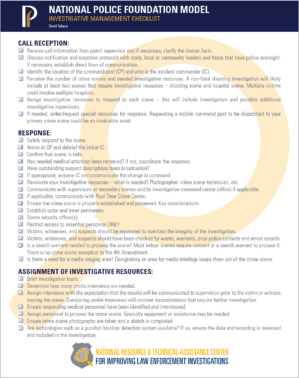Publications
The various public safety professionals involved in responding to a crime scene, whether patrol officer, detective, firefighter or EMT, are all tasked with rapidly responding to provide aid to those in need and secure the scene all while preserving evidence. A swift, coordinated response is key to ensuring that critical evidence and information is not tampered with or overlooked.This quick reference guide and crime scene report template provides an overview of the roles of first responders at crime scenes and practical applications for improving collaboration and coordination. The guide was developed by Andrew Vallee, a Special Agent with the Tennessee Bureau of Investigation (TBI), who is assigned to the Technical Services Unit and specializes in digital forensics, cellular network analysis, WiFi analysis, and various other technology related disciplines.
For additional resources, see below:
Tools for Investigators
The following checklist was created by David Salazar, Captain, Milwaukee Police Department. It is intended to assist those serving in a supervisory role at the scene of a serious crime and designed to help leadership clearly outline required responses, assignment of resources, coordination with external partners (i.e. hospitals), and consideration to include as follow-up to the crime scene. The checklist is not all-inclusive; officers should always follow departmental policies and regulations directing the steps to be taken at a crime scene.
The following checklist was created by Kevin Armbruster, Retired Lieutenant from Milwaukee Police Department. It is intended to assist those first responding officers at the scene of a serious crime that may require additional resources, follow-up investigative work, and/or review by the prosecutor’s office. Patrol protocol must first follow the “Incident Response” model “R.E.S.P.O.N.D.”
Keep in mind that a crime scene is a dynamic environment and can involve responses from various public safety personnel such as patrol, detective, fire, or EMS. Each profession plays a critical role with law enforcement focused on public safety and investigating crimes. The investigative process is not necessarily a structured step-by-step process. Steps may be taken out of order depending on the discovery of information or the lack thereof. For example, an interrogation may occur at an interview room at the same time that the crime scene is processed; or the crime scene may be processed while a canvass of the neighborhood is being conducted to identify witnesses. As the primary officer, use the checklist to ensure that all the necessary components of an investigation are addressed.
The checklist is not all-inclusive; officers should always follow departmental policies and regulations directing the steps to be taken at a crime scene. If your State has a “Crime Scene Investigation” and/or “Crime Scene Evidence” collection website, you can use it as a reference at your disposal. For a formal Command Post declaration use FEMA ICS Models.





